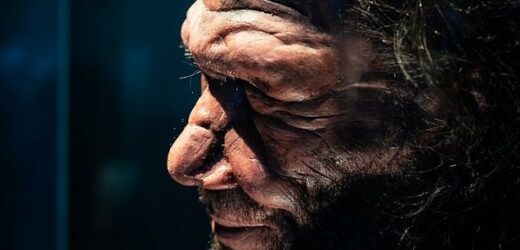Randy NEANDERTHAL may be to blame for passing on the gene that caused up to a million people to die from Covid, scientist claims
- A sexual encounter about 60,000 years ago passed on a gene that led to Covid
- Gene caused a common genetic quirk that makes lungs susceptible to infection
- Sexual encounter led to Covid deaths ‘in the hundreds of thousands to a million’
A single amorous Neanderthal may be to blame for transmitting a genetic quirk to up to a million people who died from Covid.
To date, worldwide, around 6.3 million people have died from the coronavirus which caused the pandemic.
A huge number have lost their lives because they have a relatively common genetic quirk which makes the lungs more susceptible to infection.
Now the expert whose research identified the effect of the genetic difference on the lungs has said it came from just one single ‘romantic liaison’ between a Neanderthal and a member of our own human species.
Had this one sexual act not happened 60,000 years ago, many lives would have been saved from the deadly virus.
Neanderthals were a species that lived alongside humans tens of thousands of years ago and were very similar in appearance and size but were generally stockier and more muscular (Pictured: A replica of a male Neanderthal head in London’s Natural History Museum)
WHO WERE NEANDERTHALS?
Neanderthals were a close human ancestor that mysteriously died out around 40,000 years ago.
The species lived in Africa with early humans for millennia before moving across to Europe around 300,000 years ago.
They were later joined by humans, who entered Eurasia around 48,000 years ago.
These were the original ‘cavemen’, historically thought to be dim-witted and brutish.
But in recent years, evidence points to a more sophisticated and multi-talented kind of ‘caveman’.
It now seems likely that Neanderthals buried their dead, painted and even interbred with humans.
Professor James Davies, associate professor of genomics at Oxford University’s Radcliffe Department of Medicine, told Cheltenham Science Festival: ‘If you stop and think about it, this comes from a single interspecies relationship and a single child.
‘And if the dinner date between the human and the Neanderthal had gone wrong, we would have had a much better time in Covid, and had hundreds of thousands fewer deaths.’
Asked for a rough estimate of exactly how many people may have died from Covid as a result of the 60,000-year-old sex act, he said: ‘It’s in the hundreds of thousands to a million.’
The role of the Neanderthals in making humans more susceptible to Covid was first revealed in 2020.
But the one-off ‘romantic liaison’ behind it was revealed by careful analysis of ‘letters’ in our genetic code.
DNA is made up of thousand of combinations of the letters A, C, G and T, which represent four different chemicals.
But people with the high-risk genetic quirk for Covid have exactly the same 28 differences in the letters of their genetic code.
That makes it almost certain they are all descended from the same two people, rather than the product of lots of Neanderthals having sex with many Homo sapiens.
It’s already thought that Neanderthal genes are a cause of more severe symptoms of Covid.
A genetic variation is present in modern-day humans because our ancestors had sex with Neanderthals about 60,000 years ago.
People who have the variation, found on chromosome three, are up to three times more likely to need ventilation if they catch the virus.
Read more
Professor Davies told the science festival: ‘We think it’s a single romantic liaison, and the reason we know that is that it’s inherited as this block with 28 single-letter changes, and you can track that all the way back and it has to be a single event.’
Simon Underdown, professor of biological anthropology at Oxford Brookes University, who also addressed the festival audience, said: ‘I want you to keep in mind, when we start thinking about the time when Neanderthals and Homo sapiens bumped into each other and went on that dinner date, just how far back in time this was, and 60,000-odd years later, we are seeing the impact of that encounter in the world today in more severe forms of Covid.’
He added: ‘The average Neanderthal group size is estimated to be about 20 to 25 individuals, so these are tiny, tiny little groups dotted across a continental scale.’
He described the chances of Neanderthals bumping into each other, let alone Homo sapiens, as ‘unlikely’, making the sexual encounter that introduced the Covid-related gene into modern humans remarkable.
Once the Neanderthals and Homo sapiens met, they are unlikely to have realised they were different species, so happily interbred.
The genetic variation which some people now have, and came from the Neanderthals, is linked to a gene called LZTFL1 and is believed to act on lung cells.
These cells develop more of an important protein on their surface, which the coronavirus is able to latch on to and spread through the lungs, causing more damage which can be deadly.
The genetic quirk is more common in people of south Asian origin, and could partially explain the high death toll in India during the pandemic.
Professor Davies said: ‘If you stop and think about it, this comes from a single interspecies relationship and a single child.
‘And if the dinner date between the human and the Neanderthal had gone wrong, we would have had a much better time in Covid, and had hundred of thousand fewer deaths.’
However Neanderthal genes have also been suggested to help humans by making us more intelligent, helping us quickly adapt to new diets and boosting the immune system to help fight off harmful viruses and bacteria.
GENES, GENOMES AND DNA: A PRIMER
Gene: a short section of DNA
Chromosome: a package of genes and other bits of DNA and proteins
Genome: an organism’s complete set of DNA
DNA: Deoxyribonucleic acid – a long molecule that contains unique genetic code
Your genome is the instructions for making and maintaining you. It is written in a chemical code called DNA. All living things – plants, bacteria, viruses and animals – have a genome.
Your genome is all 3.2 billion letters of your DNA. It contains around 20,000 genes.
Genes are the instructions for making the proteins our bodies are built of – from the keratin in hair and fingernails to the antibody proteins that fight infection.
Source: Genomics England/Your Genome/Cancer Research
Source: Read Full Article



